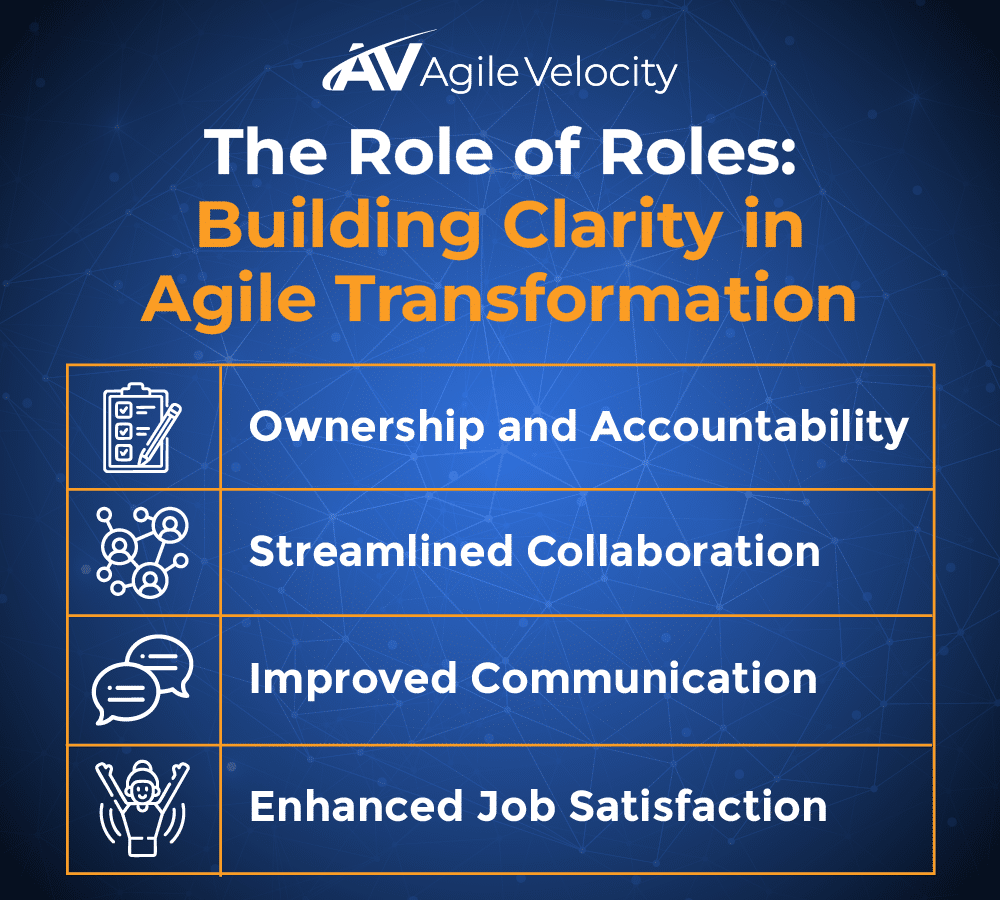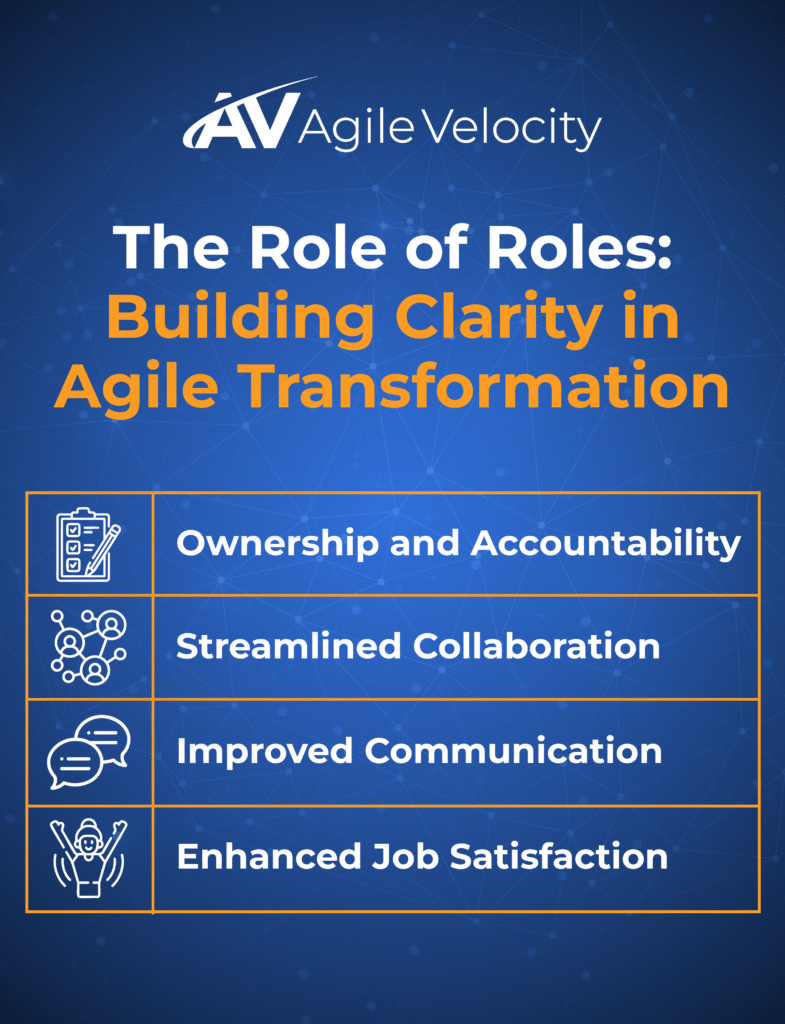Embarking on an Agile Transformation is more than just introducing new processes. It reshapes how your organization collaborates, delivers value, and adapts to change. Success depends on choosing the right framework and on clearly defined roles—one of several critical elements that drive progress. When responsibilities are understood and empowered, teams work in ways that foster agility and continuous improvement.
In this article, we explore the pivotal roles that power Agile success. We break down each role’s key responsibilities and demonstrate how they contribute to a sustainable transformation. Well-articulated role definitions can enhance organizational alignment and support long-term agility alongside other essential factors like strong leadership, a supportive culture, and targeted training.
Understanding Agile Transformations
An Agile Transformation represents a shift from traditional, rigid structures to a culture of adaptability, cross-functional collaboration, and continuous learning. The goal is to help businesses pivot quickly and deliver better outcomes using iterative cycles and an outcome-focused approach.
Agile Transformation goes beyond frameworks such as Scrum or Kanban. It means adopting new ways of working that create real business value. When roles are clearly described and integrated with supportive cultural and leadership practices, miscommunication is minimized, allowing teams to focus on delivering value in dynamic markets.
The Importance of Defining Roles
Clearly defined roles are a critical element of any transformation. When every team member knows their responsibilities, alignment improves, collaboration strengthens, and workflows become more efficient. Well-articulated role definitions reduce confusion and overlapping tasks by establishing who to consult for guidance and decisions.
Role clarity offers several advantages:
- Ownership and Accountability: Individuals confidently take initiative and make decisions.
- Streamlined Collaboration: Defined roles reduce duplicated efforts and fill task gaps.
- Improved Communication: Teams know exactly whom to approach for specific issues, minimizing delays.
- Enhanced Job Satisfaction: Employees feel more engaged and valued when their contributions are clearly linked to organizational success.
It is important to note that while clearly defined roles are essential, they operate alongside factors such as leadership, culture, and training to drive a robust transformation. Empowerment goes hand in hand with clarity; every role should have the autonomy needed to deliver results. Trust, transparency, and accountability drive long-term organizational agility.
The Scrum Master
The Scrum Master is the cornerstone of team productivity and collaboration within a Scrum framework. In addition to ensuring that events such as Sprints, Sprint Planning, Sprint Review, and Sprint Retrospective run smoothly, the Scrum Master teaches Agile principles and removes obstacles.
Responsibilities of a Scrum Master
- Champion of Scrum Practices: Leads by example, ensuring that each Scrum event drives actionable progress.
- Removing Barriers: Actively eliminates obstacles that slow the team.
- Shielding the Team: Protects team members from external disruptions so they can focus on the Sprint Goal.
- Driving Continuous Improvement: Facilitates retrospectives that help teams reflect and adapt.
Scrum Masters work closely with other roles to maintain transparency and accountability, ensuring team efforts align with broader organizational goals.
The Product Owner
The Product Owner bridges strategy and execution by maximizing a product’s value. This role sets priorities, communicates a clear vision, and aligns development teams with stakeholders.
Key Responsibilities
- Managing the Product Backlog: Prioritizes and refines tasks to focus on those with the highest impact.
- Voicing Stakeholder Needs: Translates business requirements into clear, actionable tasks.
- Creating a Feedback Loop: Adjusts priorities based on input from the team and stakeholders.
- Collaborating in Agile Events: Actively participates in planning sessions and clarifies acceptance criteria.
By explaining both the “what” and the “why,” the Product Owner ties strategy to execution, ensuring that planning remains focused and adaptable.
The Agile Coach

Agile Coaches guide organizations through transformations that go beyond individual teams. They use their experience with frameworks like Scrum, Kanban, SAFe® (Scaled Agile Framework®), and others to ensure effective adoption and scaling of Agile practices.
Why Agile Coaching is Essential
- Mentoring Teams and Leaders: Coaches help individuals adopt Agile behaviors and foster a mindset that embraces change.
- Scaling Practices: Bridges gaps between various Agile methods while keeping workflows consistent.
- Fostering Organizational Alignment: Promotes a shared understanding of Agile principles.
- Focusing on Outcomes: Shifts attention from rigid processes to delivering tangible business results.
Agile Coaches support all roles by suggesting improvements early and ensuring that challenges are addressed promptly.
Leadership Roles in SAFe Agile Practices
Within the Scaled Agile Framework® (SAFe®), leadership connects strategy with execution across large organizations. Key leadership roles guide teams, synchronize efforts, and nurture a culture of agility.
Business Owners (BO)
Business Owners (BO) link strategic vision with day-to-day execution. They provide clear direction, allocate resources, and monitor progress to keep teams aligned with company goals. Leaders like Business Owners (BO) play an essential role in grounding transformation efforts.
Product Owners in a Scaled Context
In SAFe environments, Product Owners work as part of a broader hierarchy. They ensure that multiple teams align with the program backlog for consistent delivery across Agile Release Trains.
Release Train Engineer
The Release Train Engineer acts as a “chief Scrum Master” for the Agile Release Train. They coordinate planning sessions such as PI Planning and ensure smooth collaboration across teams.
Leadership in the Scaled Agile Framework relies on Lean thinking and servant leadership. When Business Owners (BO), Product Owners, and Release Train Engineers work in concert, they reduce bottlenecks and maintain focus on strategic priorities.
Cross-Functional Collaboration and Team Dynamics
Effective Agile success depends on breaking down silos through cross-functional collaboration. When teams combine diverse skills, they work more efficiently on shared goals, make faster decisions, and spark innovative ideas.
Benefits of cross-functional teams include:
- Faster Decisions: Combined expertise leads to quicker problem-solving.
- Shared Ownership: Collective responsibility boosts morale and accountability.
- Greater Transparency: A unified project view improves overall quality.
- Enhanced Innovation: Different perspectives nurture creative solutions.
Leaders must encourage open communication and create an environment where real-time problem solving is natural. Investing in regular team-building exercises and communication workshops further solidifies these cross-functional relationships. When teams understand each other’s roles and challenges, the foundation for a well-aligned organization is set. This environment promotes mutual respect and a collective drive toward continuous improvement, ultimately leading to higher rates of success in Agile projects.
The Impact of Agile Culture on Role Empowerment
A thriving Agile culture directly influences the effectiveness of each role. When an organization embraces values like transparency and ownership, every team member feels empowered to experiment and innovate. This cultural shift transforms traditional hierarchies into collaborative ecosystems. In such environments, feedback is not just welcomed but actively sought, ensuring that roles are continuously refined based on real-world performance and emerging best practices.
Establishing an Agile culture starts with leadership modeling behaviors that prioritize learning over blame. In organizations where leaders actively participate in Agile events and promote accountability, the benefits are tangible. Employees are more likely to innovate when they know that failures are seen as opportunities for growth rather than reasons for punitive action. This supportive environment fosters resilience, adaptability, and long-term operational excellence, driving sustainable business value.
Leveraging Path to Agility® Navigator
Achieving role clarity during an Agile Transformation can be challenging. Agile Velocity’s Path to Agility® Navigator defines roles, maps objectives, and tracks progress throughout your journey. This tool visually aligns responsibilities with outcomes, empowering teams and leaders to work purposefully.
Defining and Aligning Roles with Outcomes
Path to Agility® Navigator illustrates how each role contributes to business success:
- Scrum Masters: Enhance team flow and remove impediments.
- Product Owners: Organize and prioritize the Product Backlog to drive customer value.
- Agile Coaches: Instill a culture of continuous improvement.
Tracking Progress
Path to Agility® Navigator offers iterative evaluations that allow leaders to pinpoint performance gaps. Data-driven insights keep Agile practices aligned with strategic goals.
Supporting Sustainable Transformations
By focusing on adaptability and measurable outcomes, Path to Agility® Navigator becomes a fundamental element of your organization’s operations rather than a temporary initiative. It provides the structure and insights necessary for ongoing success.
Actionable Steps for Empowering Agile Roles
Empowering Agile roles requires more than adopting a framework—it calls for constant support, targeted training, and regular feedback. Here are some practical steps:
- Provide Role-Specific Training: Offer focused workshops, coaching sessions, and training programs to deepen understanding of roles such as Product Owner, Scrum Master, and Agile Coach.
- Clearly Define Responsibilities: Document each role’s tasks and accountabilities to reduce overlap and ensure effective decision-making.
- Link Roles to Measurable Outcomes: Set clear performance metrics—such as team velocity and stakeholder satisfaction—to underscore the value of each role.
- Foster a Culture of Feedback: Encourage regular retrospectives and feedback sessions to build trust and uncover opportunities for improvement.
- Lead by Example: Ensure leaders actively practice Agile principles by participating in Agile events and promoting transparency.
- Support Career Growth: Invest in internal talent through mentorship, shadowing, and leadership development programs to cultivate and sustain Agile expertise.
Overcoming Challenges in Role Implementation
Transitioning to clearly defined Agile roles may present challenges, including resistance to change, unclear responsibilities, or insufficient training. To overcome these obstacles:
- Identify Pain Points: Use surveys and feedback sessions to discover where roles overlap or are vague.
- Develop Clear Role Narratives: Create concise role descriptions that specify responsibilities, expected outcomes, and decision-making authority.
- Invest in Training Programs: Implement thorough onboarding for new team members and provide continuous learning for existing staff.
- Enable Open Communication: Foster active dialogue between leadership and teams so every member feels heard.
- Measure Progress: Regularly assess role effectiveness using data-driven metrics and adjust responsibilities as needed.
Integrating Role Clarity into Organizational Culture
Successful Agile Transformations require that role clarity be woven into the very fabric of your organizational culture. Here are some strategies to integrate role clarity:
- Celebrate Success Stories: Share examples where clear role definitions and the supportive involvement of leadership and team education led to improved outcomes, motivating teams to embrace best practices.
- Establish Role Champions: Appoint experienced Agile practitioners to mentor others and guide consistent role practices. Emphasizing role clarity alongside other critical transformation elements is key.
- Align Roles with Organizational Goals: Ensure every role directly supports the organization’s strategic objectives.
- Review and Evolve Regularly: Periodically update role definitions to reflect new challenges and opportunities as the market evolves.
Sustaining Agile Role Effectiveness Over Time

For lasting success, organizations must continually assess and adapt their Agile roles. Regular feedback sessions and objective performance metrics ensure that the roles remain relevant and effective.
Encouraging every team member to grow supports adaptability. In today’s dynamic market, the ability to pivot and adjust roles is crucial. Regular revisiting and refining role definitions ensure your organization remains agile and responsive to change. Empowering teams to evolve naturally creates resilience and aligns strategic priorities with shifting market demands.
Continuous Learning and Improvement Using Metrics
Tracking performance metrics is key to refining Agile roles. Establish clear, measurable criteria—such as team velocity, quality of deliverables, and customer satisfaction—to demonstrate how well-defined roles drive results. These insights help pinpoint areas for improvement and keep your Agile Transformation responsive. Advanced digital tools can further enhance this process by offering real-time dashboards and automated alerts, enabling quicker adjustments and fostering a culture of performance metrics.
The Future of Agile Transformations
Looking ahead, the landscape of Agile Transformations is set to evolve as technology and business needs change. Organizations are increasingly expected to integrate digital solutions with traditional Agile practices. Emerging trends include the adoption of AI systems in team performance monitoring and more dynamic, adaptive training programs that can respond to real-time feedback. Organizations that prepare for these changes by continuously updating their role definitions and performance metrics will enjoy a competitive edge. Staying informed about industry developments and integrating new tools will ensure that Agile practices remain flexible and robust. This proactive mindset primes teams for both current challenges and unforeseen future opportunities.
Additional Considerations for Real-World Application
In practice, mature role clarity combined with strategic leadership, culture, and continuous training can directly contribute to reduced project delays and improved team morale. Organizations that update their practices and educate team members routinely often see measurable benefits, including smoother transitions and reduced risks during transformation.
Is Your Team Equipped with the Right People for the Job?
Clearly defined roles are an essential element for driving a lasting Agile Transformation. A focused Scrum Master keeps teams on track, a decisive Product Owner connects strategy with execution, and an Agile Coach fosters continuous improvement. When these roles are supported by strong leadership, a collaborative culture, and dedicated training, they collectively drive transformative success.
Ready to drive transformative change? Explore Agile Velocity’s Agile Staffing services for a first step towards stacking your team with the right talent.





